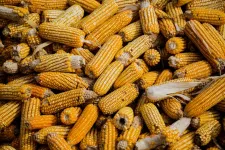(Press-News.org) WASHINGTON -- Researchers have developed a new laser-based process for 3D printing intricate parts made of glass. With further development, the new method could be useful for making complex optics for vision, imaging, illumination or laser-based applications.
"Most 3D printing processes build up an object layer by layer," said research team leader Laurent Gallais from The Fresnel Institute and Ecole Centrale Marseille in France. "Our new process avoids the limitations of these processes by using a laser beam to transform -- or polymerize -- a liquid precursor into solid glass."
In The Optical Society (OSA) journal Optics Letters, Gallais and research team members Thomas Doualle and Jean-Claude Andre demonstrate how they used the new technique to create detailed objects in a 3D volume without using the classical layer-by-layer approach. Using this approach, they created a variety of silica glass objects such as miniature models of a bike and the Eiffel Tower without any pores or cracks.
The 3D printing approach is based on multiphoton polymerization, which ensures that polymerization, a process that links liquid monomer molecules together into a solid polymer, only takes place at the precise laser focal point. It allows direct fabrication of 3D parts that range in size from a few microns to tens of centimeters with a resolution that is theoretically only limited by the optics used for laser beam shaping.
"Glass is one of the primary materials used to make optics," said Gallais. "Our work represents a first step toward developing a process that could one day allow scientists to 3D print the optical components they need."
Finding the right material
Using a traditional layer-by-layer approach to build 3D glass objects comes with several limitations. The speed of the printing process is limited by the time it takes to build the layers, and it can be difficult to create layers with consistent thicknesses when using highly viscous resins. Making complex parts typically requires supports, which must be precisely positioned and then removed once the object hardens.
Although multiphoton polymerization can be used to avoid the layer-by-layer approach, 3D printing glass objects requires a material that is transparent at the wavelength of the laser both during the initial liquid phase and once polymerized. It must also absorb the laser light at half the laser wavelength to initiate the multiphoton polymerization process.
To accomplish this, the researchers used a mixture containing a photochemical initiator to absorb the laser light, a resin and high concentration of silica nanoparticles. In addition to working well with the laser, this mixture's high viscosity allows a 3D part to be formed without deformation problems or supports to keep the object in place during 3D printing.
"Critical to the technique were high power ultrashort lasers based on Strickland and Mourou's chirped pulse amplification technology recognized with a Nobel prize in 2018," said Gallais. "Only intense and very short pulses will create non-linear photo polymerization with high precision and no thermal effects."
Testing the process
After validating that a solid object could be created using the silica nanoparticle mixtures, the researchers used their 3D printing approach to create objects with complex shapes. They also applied a process that transforms the polymerized parts into glass.
"Our approach could potentially be used to produce almost any type of 3D glass object," said Gallais. "For example, we are exploring the possibility of producing glass parts that could be used on luxury watches or perfume bottles."
The researchers are working to make the technique more practical and reduce cost by experimenting with less expensive laser sources, for example. They also want to optimize the process to improve the surface quality to decrease roughness.
INFORMATION:
Paper: T. Doualle, J.-C. Andre, L. Gallais, "3D-printing of silica glass through multiphoton
polymerization process," Opt. Lett., 46, 2, 364-367 (2021).
DOI: https://doi.org/10.1364/OL.414848 .
About Optics Letters
Optics Letters offers rapid dissemination of new results in all areas of optical science with short, original, peer-reviewed communications. Optics Letters accepts papers that are noteworthy to a substantial part of the optics community. Published by The Optical Society and led by Editor-in-Chief Miguel Alonso, Institut Fresnel, École Centrale de Marseille and Aix-Marseille Université, France, University of Rochester, USA. Optics Letters is available online at OSA Publishing.
About The Optical Society
Founded in 1916, The Optical Society (OSA) is the leading professional organization for scientists, engineers, students and business leaders who fuel discoveries, shape real-life applications and accelerate achievements in the science of light. Through world-renowned publications, meetings and membership initiatives, OSA provides quality research, inspired interactions and dedicated resources for its extensive global network of optics and photonics experts. For more information, visit osa.org.
Media Contact:
mediarelations@osa.org
The abundant presence of an enzyme known as low molecular weight protein tyrosine phosphatase (LMWPTP) in tumor cells has long been considered an indicator of cancer aggressiveness and metastatic potential. It is also known to perform important functions in cells under normal conditions, participating in both the proliferation process and the regulation of intracellular systems. Research continues on its role in cancer progression.
In Brazil, a group of researchers at the University of Campinas’s In Vitro Bioassay and Signal Transduction Laboratory led by Professor Carmen Veríssima Ferreira-Halder are studying the possibility of inhibiting this protein phosphatase ...
Scientists have determined the optimal conditions following a stem cell transplant that could control HIV without the need of an everyday pill, according to a study published today in eLife.
Finding the right balance of stem cell dose, cell type and timing of antiretroviral therapy (ART) could potentially lead to a spontaneous cure of HIV.
There are only two cases of HIV cure to date: the Berlin Patient and the London Patient, who both received stem cell transplants with stem cells from donors that lack a molecule called CCR5, which HIV is attracted to.
"The major obstacle to HIV eradication is a latent reservoir of long-lived infected cells, and cure strategies aim to eliminate all infected cells or permanently prevent viral reactivation ...
Understanding the immune systems of oysters and clams is important in monitoring the effects of pollution and climate change on the health of molluscan species and the potential impacts on the aquaculture industry. Their immune responses also can serve as indicators of changes in ocean environments.
A new study involving the University of Maine assessed immune responses in four economically important marine mollusc species -- the blue mussel, soft-shell clam, Eastern oyster, and Atlantic jackknife clam -- and identified new biomarkers relating to changes ...
BOSTON -- Reprogramming the rich connective tissue microenvironment of a liver cancer known as intrahepatic cholangiocarcinoma (ICC) inhibits its progression and resistance to standard chemotherapy in animal models, researchers from Massachusetts General Hospital (MGH) have found. This new treatment for a disease with extremely poor outcomes uses antibodies to block placental growth factor (PlGF), a member of the vascular endothelial growth factor (VEGF) family, which has been widely studied for its role in new vessel formation in cancers. PlGF is highly expressed ...
ORLANDO, Jan. 12, 2021 -Vehicles have evolved to become more efficient and sophisticated, but their fuel hasn't necessarily evolved along with them. The Department of Energy is determined to identify cleaner burning and renewable alternatives to gasoline, and through the work of two UCF researchers, the DOE is one step closer to that goal.
Research engineer Anthony C. Terracciano and Associate Professor Subith Vasu have developed a model that will help engine designers, fuel chemists and federal agencies determine whether certain biofuels should be implemented as an alternative fuel ...
January 12, 2021 - A change in evidence-based guidelines for vasectomy may have led to a reduction in the number of follow-up tests to confirm the procedure was successful, reports a study in Urology Practice®, an Official Journal of the American Urological Association (AUA). The journal is published in the Lippincott portfolio by Wolters Kluwer.
Originally published in 2012, and then updated in 2015, the AUA clinical guideline could significantly reduce the number of men undergoing multiple postvasectomy semen analyses (PVSAs) to confirm it's safe to stop using other methods of birth control, according to new research by Tony Chen, MD, of University of Washington, ...
One-third of the fertilizer applied to grow corn in the U.S. each year simply compensates for the ongoing loss of soil fertility, leading to more than a half-billion dollars in extra costs to U.S. farmers every year, finds new research from the University of Colorado Boulder published last month in Earth's Future.
Long-term soil fertility is on the decline in agricultural lands around the world due to salinization, acidification, erosion and the loss of important nutrients in the soil such as nitrogen and phosphorus. Corn farmers in the U.S. offset these losses with nitrogen and ...
Every field has its underlying principles. For economics it's the rational actor; biology has the theory of evolution; modern geology rests on the bedrock of plate tectonics.
Physics has conservation laws and symmetries. For instance, the law of conservation of energy - which holds that energy can neither be created nor destroyed -- has guided research in physics since antiquity, becoming more formalized as time went on. Likewise, parity symmetry suggests that switching an event for its mirror image shouldn't affect the outcome.
As physicists have worked to understand the truly bizarre rules ...
Most flowering plants depend on pollinators such as bees to transfer pollen from the male anthers of one flower to the female stigma of another flower, enabling fertilization and the production of fruits and seeds. Bee pollination, however, involves an inherent conflict of interest, because bees are only interested in pollen as a food source.
"The bee and the plant have different goals, so plants have evolved ways to optimize the behavior of bees to maximize the transfer of pollen between flowers," explained Kathleen Kay, associate professor of ecology ...
COLUMBUS, Ohio - For those trying to live a healthy lifestyle, the choice between sugar and artificial sweeteners such as saccharin can be confusing. A new study led by researchers at The Ohio State University Wexner Medical Center and The Ohio State University College of Medicine found the sugar substitute saccharin doesn't lead to the development of diabetes in healthy adults as previous studies have suggested.
The study findings are published in the journal Microbiome.
"It's not that the findings of previous studies are wrong, they just didn't adequately control for things like ...


